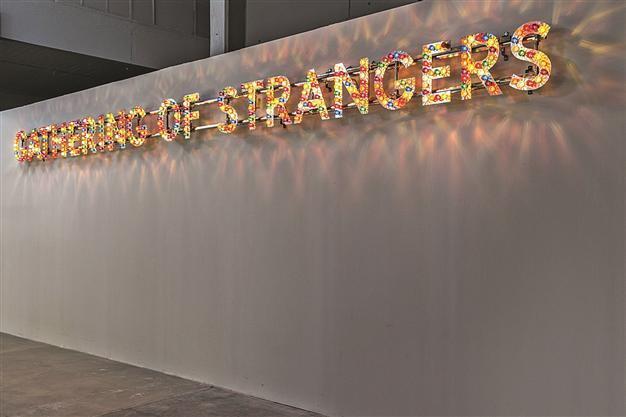13th Istanbul Biennial's poetic works tell the stories of cities
ISTANBUL – Hürriyet Daily News

The biennial addresses the idea of public space not only from the perspective of Istanbul but from all the world cities. Cities such as Prague, Jaffa, Tel Aviv and London are the main focus of the videos, art installations and photographs.
This year the 13th Istanbul Biennial focuses on the notion of the public domain as a political forum. The works in the biennial will serve as a matrix to generate ideas and develop practices and concepts of civilization in the city and how the public space has been conceived and formed in cities around the world. These works will be exhibited at a number of venues located in the centre of the city: Antrepo no.3 in Tophane, Galata Greek Primary School in Karaköy, ARTER and SALT Beyoğlu on İstiklal Street and 5533 in İMÇ 5th Block. The biennial addresses the question not only from the perspective of Istanbul but from all the world cities. Cities such as Prague, Jaffa, Tel Aviv and London are the main focus of the videos, art installations and photographs in the exhibition. It is evident that the artists’ works also focus on the perception of barbarity, while they highlight the role of art in this context; the biennial’s title “Mom, am I barbarian?” referring to poet Lale Müldür’s book of the same title, sheds light on the conceptual framework. The poetic video works, documentary photographs and drawings depict the problems, civilization, changes, culture and sub-cultures of the cities.
As the biennial text explains: “The biennial hosts 88 artists and artist collectives whose work problematizes the dichotomies between barbarity and civilization, nature and cul¬ture, the singular and the universal, the subject and the social, and randomness and order, and layer these relations visually to unravel linguistic and intellectual processes together with emotional experiences.” Featuring the works of 11 artists and two artistic/civil collectives from Turkey, as well as three artistic collaborations formed of both Turkish and foreign artists, the 13th Istanbul Biennial is one of the biennial exhibits with the highest rates of participation from Turkey to date.
Turkish artists such as Halil Altındere, Murat Akagündüz, Ayşe Erkmen, Nil Yalter, İnci Eviner, Şener Özmen,Serkan Taycan, Mahir Yavuz, Orkan Telhan and Didem Erk are displaying their works.
While some of the foreign artists preferred to create works about their own city, some preferred to create works about Istanbul. In this sense, Annika Eriksson’s video “I am the dog that was always here (loop)” at the Galata Greek Primary School, is an example of Istanbul’s reality as city, which is on the verge of urban transformation. The work focuses on street dogs, who seem to be sharing their own experiences of urban transition and experiences of marginalization.
The same situation may be observed in the works of Elmgreen and Dragset, an artistic duo based in London, UK. The duo marks their sign in very democratic and interactive works. The duo has set up a room full of desks and tables, and laid Claire Fontaine (a typical writing notebook) on the tables at Galata Greek School. The works allows people to enter the room and write on the notebooks. The writings, mostly in Turkish, focus on the killings during anti-government protests in Turkey. The duo’s work was first presented as a public invitation in 2005 entitled “Open House.” This time the duo re-interprets this work and applies it to Istanbul by emphasizing the changes undergone by the city. As part of their work they use some slogans and sentences that have been created during the Gezi Park anti-government protests.
From other cities of the worldThe world cities and the transformation that they are going through, or the changing situation of their locals, are depicted in the works of artists in this 13th Istanbul Biennial. Egyptian artist Amal Kenawy tries to depict the public interventions through metaphors and poetic means in his video “Silence of Sheep” from 2009. The video is a performance of Kenawy. She led 15 people crawling on their hands and knees, across a street. Some people photographed the event while some got angry.
A work that shows Rio de Janeiro by Brazilian artist Carlos Eduardo Felix da Costa, titled “Seasons” is a proposition of ideas for building of green architecture in the mountains of Rio de Janeiro. The work is consisted of a video, photos and architectural models. On the other hand, Edi Hirose’s work focuses on his natal town of Lima. The work is about the Lady of Lourdes cemetery and Hirose shows the rapidly changing demographics of the city around the cemetery. The migrants and locals are the main characters in the works.
Maybe one of the most poetic works of the biennial is Shahzia Sikander’s 12-minute HD animation three-channel video work titled “Parrallax.” Sikander previously showed the work at the Sharjah biennial earlier. However, for the 13th Istanbul Biennial Sikander made a new edition of the work.
Sikander shows the audience psychological and geographic spaces in contested regions, while she incorporates local perspectives and collaborations into her project, creating a view that transgress the obvious specific place, said Clare Butcher, adding that Sikander affiliated the logic of poetry with the symbolic impact of the miniature. Maybe Sikander’s work is one of the best examples that prove how a video work can work with paintings, symbols and sound.
From the Turkish artists, Halil Altındere, who has two works in Salt Beyoğlu and also in Antrepo, prefers to document the reality of the people of Sulukule in his video. The video shows a part or sub-culture of the situation and also the inevitable truth that all locals have lived with since 2006. While the artist shows an approach to urban transformation, the video depicts the reflection of anger, resistance and sorrow.
